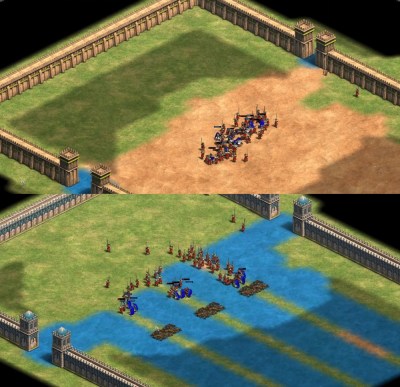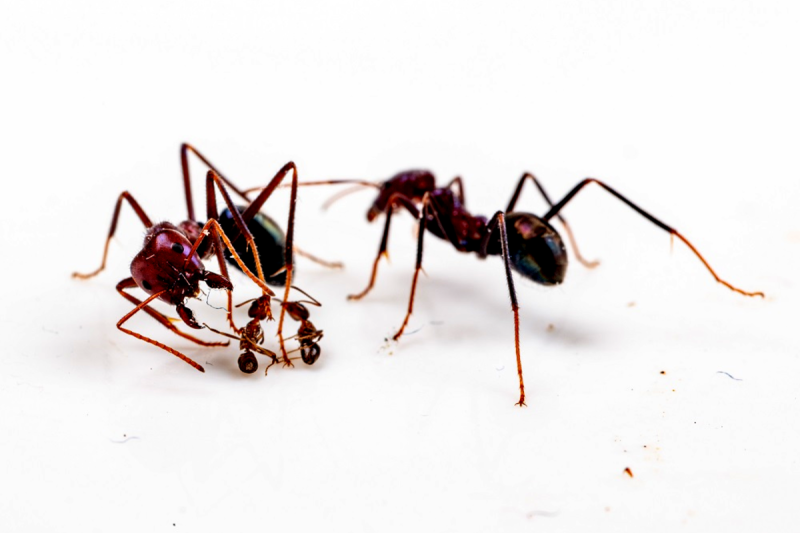Australia’s native meat ants are struggling. Invasive species of foreign ants have a foothold on the continent, and are increasingly outcompeting their native rivals for territory. Beyond simple encroachment, they pose a hazard to native animals and agriculture.
Scientists at the CSIRO have been investigating the problem, hoping to find a way to halt the invasion. Charged with finding a way to help Australia’s native ants fight back, they turned to one of the most popular battle simulations of all time: Age of Empires II.
Lanchester’s Laws

The work by the CSIRO aimed to investigate the dynamics of conflict between Australia’s native meat ants and the smaller invasive Argentine ant species. The latter are much smaller than the local Australian ants, with the Argentine species tending to live in huge, dense colonies that are highly cooperative in behaviour.
In one-on-one combat, the native meat ant will always win against the Argentine invader, by virtue of its much larger size. However, in the real world, a meat ant might find itself overwhelmed in combat by the sheer numbers of Argentine soldier ants that show up to battle.
The researchers aimed to determine how this numerical advantage worked in various scenarios. It’s a topic that has been explored deeply in military contexts, with English engineer Frederick William Lanchester noted for his work on the problem in the early 1900s. He developed mathematical models that could be used to compare the progress of a battle between two armies based on their initial strengths. His laws came to be used to determine the value of a smaller number of stronger soldiers versus a much larger army of weaker individuals. In a scenario where combat occurs on a restrictive one-on-one basis, the stronger soldiers are typically favored. They can vanquish one weaker enemy before moving on to the next. However, in areas where the weaker soldiers can all attack a stronger soldier at once, the greater numbers will carry the day.
Thus, the composition of a battlefield can play a great role in the outcome of a battle. A great example of Lanchester’s work at play is the famous tale of the Greeks fighting at Thermopylae. There, a narrow pass allowed a tiny but highly capable Greek force to hold the Perisan invaders at bay, despite their overwhelming numerical superiority. Any kind of terrain or feature that restricts the swarming of a larger force around a smaller one can tilt a battle towards a numerically-weaker force made up of stronger individuals.
The CSIRO researchers used Age of Empires II to explore this mathematical concept, and relate it to combat between Australian and Argentine ant species. The game readily represents Lanchester’s laws well, and helped the researchers understand the impact of battlefield complexity on the outcome of a battle. The team noted that in the game, a small army of strong Teutonic Knights could easily best 50 units of the weaker Two-Handed Swordsman on an open field. in a more complex battle space, however, where the weaker units couldn’t all attack the Teutonic Knights at once, things changed. In these conditions, just nine Teutonic Knights could secure a victory over as many as 70 Two-Handed Swordsman.
As the researchers tried the same concepts with real ants, the same logic played out. Simple, featureless plastic arenas were more favorable to the tiny Argentine ants, as they could easily swarm the larger meat ants all at once. In more complex arenas, however, meat ants would take less casualties as the Argentine ants were restricted to attacking in smaller numbers at a time.
This has implications for conservation efforts for Australia’s native ants. Researchers have already noted that the invasive foreign ants are most prevalent in “disturbed” environments, where the landscape is simpler and undergrowth and natural debris has largely been removed. Meanwhile, the actual ant fights run by researchers, along with the battle models, indicate that a more complex environment might help the natives dominate more easily. By restoring natural debris and undergrowth, the battlefield may turn to their favor, even against far greater numbers of invasive ants.
Simplification
The idea of using a real-time strategy gaming engine to model insect warfare makes a lot of sense. Game engines allow the simulation of combat between tens, hundreds, or even thousands of individual units, allowing a proper exploration of battles at scale. It’s also possible to modify game units to suit the parameters of a given creature, with regards to things like strength, defensive armor, or the ability to attack close in or at range.
However, there are also some limitations to this methodology. Strategy game engines necessarily use abstractions to simulate combat. The vast majority of games simulate a unit like a soldier or a tank with a health bar. As the unit is attacked, its health is slowly depleted, with the unit dying when its health reaches zero. Real combat is far more complex. A human soldier might take a bullet to the hand or have a leg blown off—both survivable shots, but ones that drastically degrades their combat ability in an instant, and in different ways. Simplified strategy games rarely go beyond some window dressing, with badly injured units slowing down or attacking slower.

There’s also something to be said for the human element in setting up the scenario. Let’s say you’re simulating insect battles in Age of Empires II. How many hit points should an inch ant have? What about its pierce armor and melee armor, and damage output? For most stats beyond speed, it’s difficult to subjectively assign accurate parameters for one insect over another, without introducing some kind of human bias. Those that believe stick insects are better armored than ladybugs will unfairly rate their statistics higher, for example.
Without micromanagement by a human, such battles may also ignores tactics and strategy. Perhaps fire ants know that their cockroach enemies are readily disabled by attacks to the legs, leaving them motionless and vulnerable, making it impossible for them to fight back. Complex externalities like this generally aren’t baked into strategy game engines unless put there by design.
Some games go to great lengths to do so, such as the vehicle damage models in games like Company of Heroes, but these engines were specifically designed to more accurately represent a certain type of vehicular combat. A proper insect battle model would have to be designed from the ground up in a similar way to give reliable quantitative results for a given scenario.
However, the key to good research is often abstraction, backed up with real-world insight. That’s very much the case here. Researchers didn’t simply rely on gaming studies to inform their results, nor did they feel the need to modify the game with simulated ants. Instead, they relied on a simple model of a small force of strong soldiers versus a greater force of weaker ones. They used this to relate Lanchester’s mathematical models to both the game itself and the observations they made in actual ant combat studies from the lab. That enabled the insight that battlefield complexity favors a larger, stronger ant just as the pass of Thermopylae favored the valiant Greek defence.
Fundamentally, a game of Age of Empires II won’t be enough to guarantee success for your ant reintroduction project in any given suburb. What it can do, however, is guide conservation efforts towards tactics that could give Australia’s meat ants the best possible chance of success.
Featured image: “Two meat ants fight two smaller Argentine ant adversaries.” by Bruce Webber, CC BY-SA, CSIRO
















They should’ve used SimAnt! /jk
The strength of swarm tactics is something most games with a protagonist get wrong for gameplay reasons.
‘Heroic’ stories and similar media create the idea that a single highly trained and highly experienced soldier can simply shrug off any number of ‘peasants’.
Most game systems model this completely wrong. Usually because grappling rules are hard and not much fun.
10 peasants with bricks and sticks will defeat an armored knight or a master martial artist [1] in an open field/street 99% of the time or more.
[1] yes, the knight is also a martial artist. You know what I mean.
peasants = PEA S(ized) ANTS?
Why did this warrant AOE2? This is such an incredibly simple concept to grasp.
Is it just for pretty visuals to show to investors for why they need more money?
Also because Spirit of the Law made the Lanchester’s Law video years ago so the bulk of the work/demo was already done.
Or to justify to investors why researchers are spending so much time on AOE2
“hey! why are you guys playing Age of Empires on the lab computers?”
“uhhh … research. Yeah, research! That’s the ticket”
So this is where we’ve come to – larping ants
So is this the definite edition or the HD edition?
Looks like the HD version. Otherwise, in the battle between 20vs15 knights with equal stats, the 20 knights would’ve lost due to the pathing.
So, how are they going to train the ants in better strategies?
Is ant husbandry a thing? Keep putting gladiators in the colosseum, cycle the troops so they can learn from each other, and ensure the survivors can reproduce.
Can’t you annihilate the invasive ants with “anty matter”?
Yes, but you have to do it ex ante.